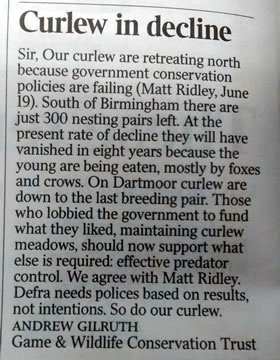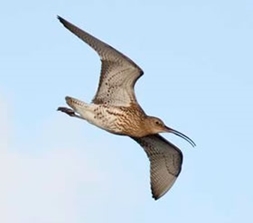 Sir,
Sir,
Our curlew are retreating north because government conservation policies are failing (Comment, June 19). South of Birmingham there are just 300 nesting pairs left. At the current rate of decline they will have vanished in eight years because the young are being eaten, mostly by foxes and crows.
On Dartmoor curlew are down to the last breeding pair. Those that lobbied the government to fund what they liked, maintaining curlew meadows, should now support what else is required, effective predator control. We agree with Matt Ridley. Defra needs polices based on results, not intentions. So do our curlew.
Andrew Gilruth
Director of Communications
Game & Wildlife Conservation Trust
Will you help us stop curlew retreating?
 We don’t want the curlew to go the way of many of our much-loved birds, like the corncrake and the nightjar. They shouldn’t be consigned to a few remote places. That is why we are asking you to support this urgent appeal for funds.
We don’t want the curlew to go the way of many of our much-loved birds, like the corncrake and the nightjar. They shouldn’t be consigned to a few remote places. That is why we are asking you to support this urgent appeal for funds.
It is estimated that there are just 300 pairs south of Birmingham, and these could disappear in just eight years. However, this isn’t just a problem facing the south. Breeding curlew have declined by 46% across the UK in just 25 years. The picture would be more widespread if curlew were not thriving on driven grouse moors.
Farmland conservation schemes have largely stabilised adult curlew numbers by halting further habitat loss.
The problem now is chick survival. The fate of the curlew is literally in the hands of farmers and gamekeepers - we need to get the right advice out there fast.
How you can help
£25 could help us to get our practical guidelines in the hands of those on the ground who can bring about curlew recovery
£100 could help us to highlight how current conservation policy is failing to give curlew the best chance of recovery by briefing journalists and politicians
£250 helps us to get advisors out to curlew sites and assess what can be done to aid their recovery on the ground this year